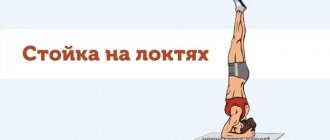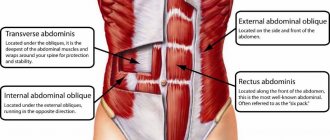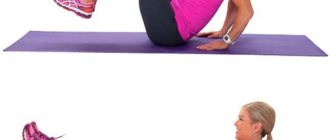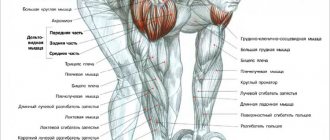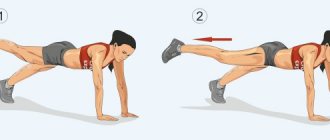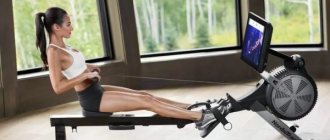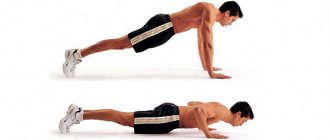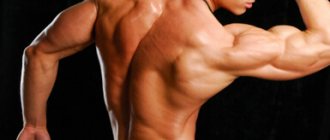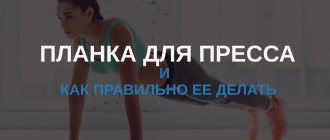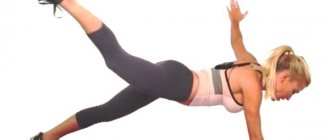FacebookTwitterPinterestEmailWhatsAppVKontakte
The plank is perhaps the best exercise for strengthening your core and abdominal muscles. By regularly performing various types of plank exercises for 15 minutes, you can improve your flexibility and overall body condition, improve your mood and reduce back pain, as well as lose weight and get a flat stomach. In fact, people who consistently do elbow stands and other variations of this movement feel much more confident anytime, anywhere! So let’s roll up our sleeves and learn how to correctly perform this wonderful movement and at the same time figure out how the plank exercise is beneficial for the body of women and men!
What is a plank?
The plank is an exercise with your own body weight. It is also known as Kumbhakasana (in Sanskrit) and is part of one of the main complexes of yoga, the Sun complex. For a few minutes, you support your body on your toes and forearms while your head looks down (or to the side). This is a static exercise that does not require any equipment. Its effectiveness is enormous, which will be discussed in the next section.
How is exercise useful?
Doing this type of exercise regularly can benefit you in many ways. From helping you lose weight and get a flat and beautiful tummy to improving your mood. The following is a list of other benefits of the plank exercise for women:
- Improves posture. Planks strengthen your core and lower back muscles, thereby improving your posture.
- Reduces belly fat. A saggy belly is a must-have gift that most of us receive as a result of bad habits. If you want to remove all those extra centimeters, then you just need a bar. By building and strengthening your core muscles, you can instantly strengthen your abs.
- Improves flexibility. Planks are great for improving flexibility.
- Reduces back pain. If you suffer from back pain, planking may be one of the solutions to get rid of it. Since this exercise targets the core and back muscles, it strengthens them, thereby reducing back pain.
- Improves mood. Doing planks will help improve your health and produce pleasure hormones. This is a great way to build confidence and do everything with enthusiasm.
- Builds endurance. The longer you can hold a plank, the better you will be at all other exercises. This is a proven fact.
Now you know why the plank is useful and why you should do it. Let's now find out what the technique is for performing the standard plank and its variations.
Types of planks
There are several varieties of such training, which differ in the position of the body and limbs, however, they have the same rules and a similar methodology. Each type focuses on different muscle groups.
Straight arm plank
The extended arm plank is a classic variation of the exercise. It is necessary to take a lying position from which push-ups are performed. It is important to keep the body straight, do not arch the lower back and do not raise the pelvis. With every second, the tension in the abdominal area will increase. Try to hold this position for as long as possible.
The body weight is distributed over the supporting points - palms and feet. We must remember to keep the muscles of the abdomen, back and legs tense, so that you can achieve the desired result. The classic plank is an excellent method for working out the abs and strengthening the entire body.
Elbow plank
This is the second version of the classic plank, in which the arms should be bent at the elbows at an angle of 90˚ and placed in a straight line with the shoulders. This is a more difficult method of execution, since the angle between the body and the surface becomes smaller, so it is much more difficult for the athlete to keep the body tense. With this variation of the exercise, not only the abs are used, but also the muscles of the chest, knitting needles and the front surface of the thigh.
Plank with leg or arm extended
This variety is highly difficult, as the stabilizing muscles begin to function at their maximum capabilities, and the athlete also concentrates on maintaining balance.
First you need to take a classic position, then tear your arm or leg off the surface. At the same time, it is important to monitor the position of the body; you should not raise your pelvis and throw your head back. People in good physical condition can raise their arm and the opposite leg at the same time and maintain this position. This method is more effective due to fewer support points.
Side plank
It is performed from a side lying position. You need to stand on your arm, bent at the elbow joint, the lower parts of your legs should be closed, your pelvis should be lifted off the floor. Keep your top hand on your belt or raise it up. The abs, back and gluteal muscles should be tense to keep the body as straight as possible without leaning to the sides.
The side plank helps pump the muscles of the buttocks and strengthen the abdominal muscles.
General rules for performing the exercise
- Keep your shoulder blades retracted.
- Your buttocks and thighs should be in the same line.
- Keep your glutes and core engaged.
- Don't strain your neck. Keep it in a neutral position, looking down at the floor or up at the ceiling.
- Under no circumstances should you allow your lower back to sag too much.
While the plank is a great exercise, it may not be the best exercise for some of you. Find out if you should give it up completely.
What muscles are involved when doing a plank?
One of the main advantages of the plank is that it works the core muscles - the so-called muscles of the abdominals and back of the back; a tense position allows you to keep them in good shape. The Core muscles give our body the ability to position itself vertically - stand and walk. This is also a highly effective exercise that involves many other muscle groups:
- Arm muscles - all variations of the exercise involve the forelimbs. In the prone position, they are subjected to intense stress to properly support the body.
- The abdominal muscles are one of the most effective exercises for working out the abs. Different types of planks help strengthen the internal oblique abdominal muscles, which are difficult to work with other methods.
- Back muscles – in the plank pose, your back should be positioned straight, it is held by the spinal and intervertebral muscles.
- Muscles of the lower extremities - the pelvis is supported by weight due to the work of the muscles of the legs and hips.
- Neck muscles - the head is located in line with the body, it should not be lifted up or tilted. The neck muscles help keep your head in the correct position.
Who should not do the exercise?
If you have
- there was an operation
- pelvic pain
- I recently gave birth
- have a herniated disc
- weak bones
Remember that you should consult your trainer and doctor before performing any exercise.
Now you have all the information about the planks. There is no reason for you to stop anymore - set a goal, write it down and start doing the plank. You will see visible results within two weeks if you exercise correctly. Challenge yourself because physical fitness is just as important as intelligence. But remember that no matter how effective all types of planks are, the main thing is your motivation. Good luck!
Technique for performing the plank exercise
Technique is the most important thing when performing exercises. There are a huge number of different options for making the plank. The most popular are: hand plank , elbow plank, side plank. More advanced athletes perform exercises by lifting one or two limbs. In appearance, the exercise seems simple, but it is important not to violate the technique of its implementation, otherwise the desired effect will not be achieved.
Beginners ask questions: “How to do the plank exercise?”, “How long to do the plank?” When holding the position, you need all muscles to be as tense as possible. Productivity is determined by the individual feelings of the athlete. Ideally, muscles should “burn” and “hum” from a static load. The longer you manage to stay in the correct position, the better effect you will achieve.
It must be remembered that when doing a plank, you should keep your body as straight as possible, avoiding distortions down, up or to the side.
The undeniable advantage of such training is that the training does not require special equipment or additional devices; you can hold the bar at home while watching your favorite TV series, visiting a friend with her for company, on the beach, in the park on the grass. The main thing is that there is a flat surface underneath you.
Load calculation rules
The results of training are achieved only if the technique is performed correctly and the load is gradually increased. Excessive exercise or improper execution may cause health problems.
The load is calculated depending on the level of training.
- Beginners are advised to hold the plank for 15-30 seconds.
- People with an average level of training should hold the position for 30 seconds to 1 minute.
- Athletes and people with a good level of training are recommended to hold the position for 1-2 to 5 minutes.
You should start with the classical technique. The type of plank is changed or combined with other exercises depending on which muscles need to be worked.
How to do it correctly
The plank is an easy exercise. For it to be beneficial, you need to monitor the execution technique. During training, you will need a gymnastics mat or non-slip surface.
Starting position – emphasis lying on the floor, as for push-ups. The body rests on the toes and palms. The hands are located exactly under the shoulders. With the correct technique, it forms a straight line, the stomach is tucked, the muscles are tense.
Figure 2. The body is a straight, elongated line.
For the correct technique, you need to pay attention to some points:
- Head and neck. The neck muscles do not strain. The head is lowered down, the gaze is directed to the floor.
- Hands. When planning on your elbows, your hands lie flat on the mat or are clasped together. Elbows and hands are located under the shoulder joints. The head is not pressed to the shoulders.
- Back and lower back. The back is a straight line, as if pressed against the wall. The lower back is not arched or arched.
- Legs. The legs are an extension of the back. They are elongated and tense. Feet together or apart.
- Muscles of the buttocks and abdomen. The stomach is pulled in. The gluteal muscles and abs are tense.
- Breath. Do not hold your breath during the plank. It is smooth and deep.
Exercise duration and number of repetitions
The bar is held for as long as the muscle corset allows. The main rule is adherence to technique.
Start with 15-30 seconds. They end the workout at the moment when it becomes difficult to maintain the correct stance. It is recommended to perform from 3 to 5 approaches. The exercise is done immediately, with a short rest break, or distributed evenly throughout the day.
As training progresses, the load is increased by extending the time or changing the technique.
Figure 8. Trained athletes perform circuit training, combining types of exercise
Several steps can be used to extend the execution time:
- Trainings are carried out daily. During the day, perform 3-4 approaches.
- Additionally, they perform exercises aimed at developing other muscle groups.
- The load is increased every 4-5 days. The time is increased by 5-10 seconds or added 1 approach at a time.
- If the time in the stand has reached 1 minute or more, proceed to more complex techniques.
It should be remembered that the body adapts to stress. Therefore, techniques are regularly changed to target all muscle groups.
Training Recommendations
The plank is a unique invention in the world of fitness and a faithful assistant on the path to a healthy body and a great figure. After studying the rules of execution, start practicing. The desired result will not take long to arrive. Regular training will help you quickly strengthen your muscle corset and tighten your buttocks and sides.
If you are planning to pump up your abs, perform various exercises in combination with the plank. Every day, increase the time spent in a static position, bringing the interval to 2-3 minutes in 30 days. This scheme will allow you to achieve progress by gradually increasing the execution time.
Once you master the different types of planks, you can add them to your workout, making the process more varied. You can perform other exercises in the plank, for example, alternately raising your arms and legs, pumping the muscles of your back and buttocks. It is also advisable to add jumps, squats, push-ups, crunches, lunges and use additional equipment, such as fitball, bench, bars and weights.
Rate this article
Share link:
Contraindications
The plank allows you to achieve results and is beneficial only in the absence of contraindications. Before starting training, you should consult with your therapist and surgeon. One or more contraindications is a reason to refuse classes.
Contraindications include:
- intervertebral hernia;
- abdominal hernia;
- hypertension;
- diseases of internal organs for which physical activity is not recommended;
- post-operative and post-traumatic period;
- pregnancy;
- Diastasis.
For women, a temporary contraindication is complicated childbirth and cesarean section. They return to exercises after 1-2 months, after consulting a doctor.
Benefit
Like any active physical activity, this exercise, performed with the correct technique, only brings benefits to the body. Feedback from trainees shows that when performing side planks regularly, you can notice the following improvements:
- working out a large number of muscle fibers;
- strengthening the abdominal muscles, both oblique and rectus;
- creating a powerful muscle corset;
- development of flexibility;
- improved coordination and posture;
- reduction of back pain (especially in people suffering from scoliosis);
- the ability to perform in any conditions and without the presence of special equipment.
Plank for 30 days
If you are looking for a weight loss plank for women and men, then a table with a diagram of how to perform the exercise for a month will help you. Later, you can proportionally increase the time and number of approaches if you want to maintain and improve the result.
30-day plank table for weight loss for beginners:
| Day 1 | 20 sec/2 sets | Day 16 | 1 minute/2 sets |
| Day 2 | 25 sec/2 sets | Day 17 | 1 minute/3 sets |
| Day 3 | 25 sec/3 sets | Day 18 | 1 minute/3 sets |
| Day 4 | 30 sec/3 sets | Day 19 | 1.5 minutes/1 set |
| Day 5 | 35 sec/2 sets | Day 20 | 2 minutes/1 set |
| Day 6 | 40 sec/2 sets | Day 21 | rest |
| Day 7 | rest | Day 22 | 2 minutes/2 sets |
| Day 8 | 40 sec/3 sets | Day 23 | 2 minutes/2 sets |
| Day 9 | 40 sec/3 sets | Day 24 | 2.5 minutes/1 set |
| Day 10 | 45 sec/2 sets | Day 25 | 2.5 minutes/1 set |
| Day 11 | 45 sec/2 sets | Day 26 | 2.5 minutes/2 sets |
| Day 12 | 50 sec/2 sets | Day 27 | 3 minutes/1 set |
| Day 13 | 50 sec/3 sets | Day 28 | 3 minutes/1 set |
| Day 14 | rest | Day 29 | 3 minutes/2 sets |
| Day 15 | 1 minute/2 sets | Day 30 | 3.5 minutes/1 set |
